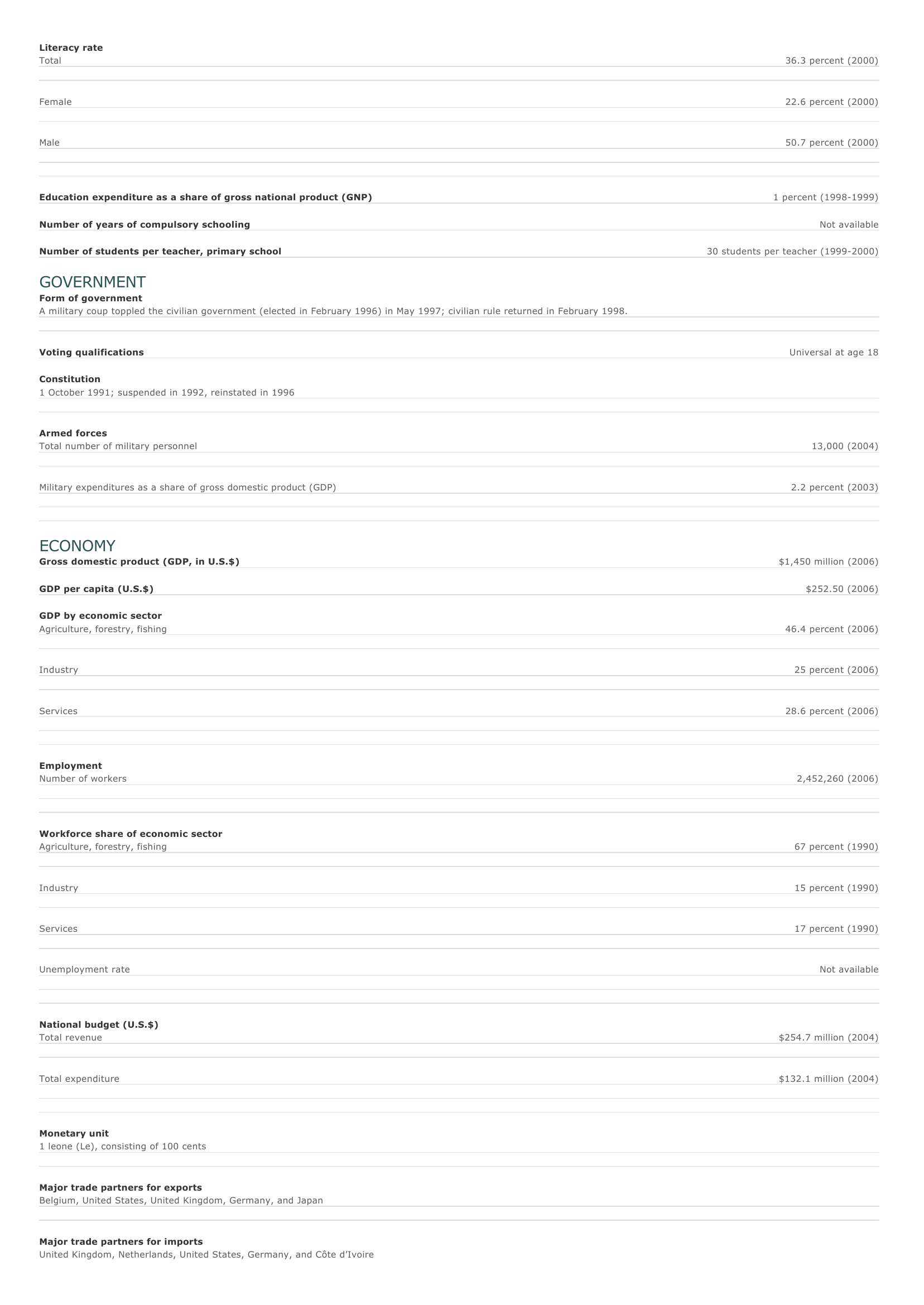
Sierra Leone Facts and Figures. BASIC FACTS Official name Capital Area Republic of Sierra Leone Freetown 71,740 sq km 27,699 sq mi PEOPLE Population 6,286,617 (2008 estimate) Population growth Population growth rate 2.28 percent (2008 estimate) Projected population in 2025 9,140,077 (2025 estimate) Projected population in 2050 13,998,936 (2050 estimate) Population density 88 persons per sq km (2008 estimate) 227 persons per sq mi (2008 estimate) Urban/rural distribution Share urban 38 percent (2003 estimate) Share rural 62 percent (2003 estimate) Largest cities, with population Freetown 921,000 (2003 estimate) Bo 269,000 (1994 estimate) Ethnic groups Black Africans, including the Mende, Temne, and Limba; Krio (Creoles); Lebanese Languages English (official), Krio, Mende, Temne Religious affiliations Muslim 46 percent Indigenous beliefs 40 percent Christian 10 percent O ther 4 percent HEALTH AND EDUCATION Life expectancy Total 40.9 years (2008 estimate) Female 43.3 years (2008 estimate) Male 38.6 years (2008 estimate) Infant mortality rate Population per physician Population per hospital bed 156 deaths per 1,000 live births (2008 estimate) 30,762 people (2004) 2,500 people (2006) Literacy rate Total 36.3 percent (2000) Female 22.6 percent (2000) Male 50.7 percent (2000) Education expenditure as a share of gross national product (GNP) Number of years of compulsory schooling Number of students per teacher, primary school 1 percent (1998-1999) Not available 30 students per teacher (1999-2000) GOVERNMENT Form of government A military coup toppled the civilian government (elected in February 1996) in May 1997; civilian rule returned in February 1998. Voting qualifications Universal at age 18 Constitution 1 October 1991; suspended in 1992, reinstated in 1996 Armed forces Total number of military personnel Military expenditures as a share of gross domestic product (GDP) 13,000 (2004) 2.2 percent (2003) ECONOMY Gross domestic product (GDP, in U.S.$) GDP per capita (U.S.$) $1,450 million (2006) $252.50 (2006) GDP by economic sector Agriculture, forestry, fishing 46.4 percent (2006) I ndustry 25 percent (2006) Services 28.6 percent (2006) Employment Number of workers 2,452,260 (2006) Workforce share of economic sector Agriculture, forestry, fishing 67 percent (1990) I ndustry 15 percent (1990) Services 17 percent (1990) Unemployment rate Not available National budget (U.S.$) Total revenue $254.7 million (2004) Total expenditure $132.1 million (2004) Monetary unit 1 leone (Le), consisting of 100 cents Major trade partners for exports Belgium, United States, United Kingdom, Germany, and Japan Major trade partners for imports United Kingdom, Netherlands, United States, Germany, and Côte d'Ivoire ENERGY, COMMUNICATIONS, AND TRANSPORTATION Electricity production Electricity from thermal sources 100 percent (2003 estimate) Electricity from hydroelectric sources 0 percent (2003 estimate) Electricity from nuclear sources 0 percent (2003 estimate) Electricity from geothermal, solar, and wind sources 0 percent (2003 estimate) Number of radios per 1,000 people 246 (1998 estimate) Number of telephones per 1,000 people 5 (2002) Number of televisions per 1,000 people 12 (2000 estimate) Number of Internet hosts per 10,000 people Daily newspaper circulation per 1,000 people Number of motor vehicles per 1,000 people Paved road as a share of total roads 0.56 (2003) 5 (1996) 3.6 (2002) 8 percent (2002) SOURCES Basic Facts and People sections Area data are from the statistical bureaus of individual countries. Population, population growth rate, and population projections are from the United States Census Bureau, International Programs Center, International Data Base (IDB) (www.census.gov). Urban and rural population data are from the Food and Agriculture Organization (FAO) of the United Nations (UN), FAOSTAT database (www.fao.org). Largest cities population data and political divisions data are from the statistical bureaus of individual countries. Ethnic divisions and religion data are largely from the latest Central Intelligence Agency (CIA) World Factbook and from various country censuses and reports. Language data are largely from the Ethnologue, Languages of the World, Summer Institute of Linguistics International (www.sil.org). Health and Education section Life expectancy and infant mortality data are from the United States Census Bureau, International Programs Center, International database (IDB) (www.census.gov). Population per physician and population per hospital bed data are from the World Health Organization (WHO) (www.who.int). Education data are from the United Nations Educational, Scientific and Cultural Organization (UNESCO) database (www.unesco.org). Government section Government, independence, legislature, constitution, highest court, and voting qualifications data are largely from various government Web sites, the latest Europa World Yearbook, and the latest Central Intelligence Agency (CIA) World Factbook. The armed forces data is from Military Balance. Economy section Gross domestic product (GDP), GDP per capita, GDP by economic sectors, employment, and national budget data are from the World Bank database (www.worldbank.org). Monetary unit, agriculture, mining, manufacturing, exports, imports, and major trade partner information is from the statistical bureaus of individual countries, latest Europa World Yearbook, and various United Nations and International Monetary Fund (IMF) publications. Energy, Communication, and Transportation section Electricity information is from the Energy Information Administration (EIA) database (www.eia.doe.gov). Radio, telephone, television, and newspaper information is from the United Nations Educational, Scientific and Cultural Organization (UNESCO) database (www.unesco.org). Internet hosts, motor vehicles, and road data are from the World Bank database (www.worldbank.org). Note Figures may not total 100 percent due to rounding. Microsoft ® Encarta ® 2009. © 1993-2008 Microsoft Corporation. All rights reserved.



































